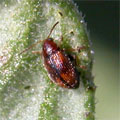pruning
Pruning is an important operation to concentrate the activity of the vine in the parts left after training and to induce sprouting of the fruitful buds located in the middle portion of the canes, which otherwise do not sprout. Pruning is done only once in annual vine growth cycle under North Indian conditions during the month of January to make the fruitful buds sprout. But in peninsular India, pruning is done twice in a year, once in summer and again in winter as vines in this region grows continuously without dormancy.
By pruning in April (summer) the vines are forced to have a rest period, which helps in better fruit bud differentiation. Pruning time is adjusted so that there is no coincidence of rainfall with fresh growth and flowering as well as the winter does not set in within 8-10 days after pruning. Summer pruning (back pruning) is done during April-May in the states of Maharashtra, Andhra Pradesh and Karnataka wherein, the canes are cut back to one or two bud level for inducing fresh vegetative growth. Vines which have attained the age of one year can be subjected to winter pruning (forward pruning) during September-November on mature (about 6 month old) current season canes. During forward pruning, entire foliage and immature shoots are removed, but levels of pruning differ with variety. Ideal canes of pencil thickness are pruned to 5 bud level in Anab-e-Shahi and Dilkush; 4 buds in Bangalore Blue and 7 buds in Gulabi, while more buds are retained on thicker canes.
Sub cane development:
The
technique of sub-cane system has almost revolutionized the
grape industry especially in seedless grapes which are tend to be
more vigorous. Halting the vigorously growing cane after back pruning
(30-35 days) at 5 leaves and developing one or two sub-canes emerging
out of the mother cane reduces greatly the problem of apical
dominance and the fertility of buds is restricted to the middle
portion of the cane. This will make the judgment of forward pruning
very easy, and long cane pruning can be avoided. With the adoption of
sub cane system in seedless varieties like Thompson Seedless, Sonaka,
Sharad Seedless and Flame Seedless, pruning is done at one or two
buds on sub cane i.e., after 6-7 buds taking mother cane also into
account. The sub canes are allowed to grow till they put forth about
7-8 leaves and the shoots are pinched off. Thus on a cane about 10-12
healthy leaves should be maintained till forward pruning. Cane
regulation during pruning:
Light pruning i.e., retention of more canes on vine results in heavy
crop, while, severe pruning i.e., retention of less canes results in
light crop. As a vine in a given season can properly nourish only a
certain load of bunches, more canes are retained on vigorous vines
but fewer canes in less vigorous vines while pruning. If a vine has
given heavy crop during the previous season, it has to be pruned
severely during the present fruiting season. Since canes that are
away from the trunk are more fruitful than the ones nearer to the
trunk, the former is pruned lightly than the latter. Partly mature
and immature canes as well as canes that taper suddenly or reversely
are sterile and are to be removed completely. Flat canes and the
canes with longer internodes also are not fruitful. It is generally
advised not to keep more than one cane per one square foot of ground
area occupied by the vine. In order to provide more light and
ventilation to the developing bunches for proper ripening, shoots are
pinched-off leaving 8-10 leaves above the bunch depending on the leaf
size, in Anab-e-Shahi, so as to provide a total leaf area of about
3000 cm2 for each bunch. Similarly in seedless grapes 7-8
leaves are retained above the bunch, to provide about 2600 cm2
of leaf area. The unproductive and auxiliary shoots are to be
removed. Generally coloured varieties like Flame seedless and Sharad
Seedless are pruned little early in the season i.e., during August or
September in dryer regions to facilitate fruit ripening during cooler
months of December-January. However, in mild tropics, pruning can be
shifted to October-November to harvest during February-March.


